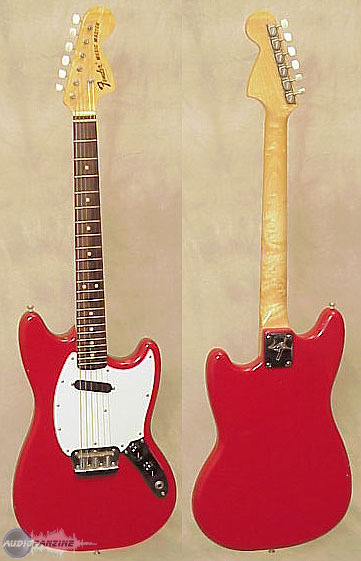Not satisfied with those reviews?
Filter
Our members also liked:
4.0/5(3 reviews)
67 %
33 %
Write a user review
Users reviews
 King Loudness
King LoudnessErm... well, it's a Fender.
Published on 01/26/12 at 18:16The Fender Music Master is a guitar that was introduced by Fender in the late fifties to have an instrument that was very simple in the features department (and in the price department) for the younger starting player. It also features a shorter scale than your average Strat or Tele, which makes it a cool choice for someone with smaller hands. It features an alder body, a maple neck with rosewood fretboard and 22 frets, standard Fender tuners, a hardtail bridge, and a single coil pickup in the neck position wired to a simple volume and tone control set. The CBS era guitars are much clunkier than their predecessors, which could also mean that contouring in the bodies went away or got more sl…Read moreThe Fender Music Master is a guitar that was introduced by Fender in the late fifties to have an instrument that was very simple in the features department (and in the price department) for the younger starting player. It also features a shorter scale than your average Strat or Tele, which makes it a cool choice for someone with smaller hands. It features an alder body, a maple neck with rosewood fretboard and 22 frets, standard Fender tuners, a hardtail bridge, and a single coil pickup in the neck position wired to a simple volume and tone control set. The CBS era guitars are much clunkier than their predecessors, which could also mean that contouring in the bodies went away or got more slight. They were built in the US of A.
UTILIZATION
The design of this guitar is ergonomic enough. Certainly the smaller design was something that would definitely appeal to players with smaller hands or of a more diminutive stature. It's reasonably lightweight, and the balance of the guitar is pretty good too. The CBS era models I've tried tend to be a little clunkier and a bit heavier too, which is just a sign of the times I suppose. The upper fret access is not too bad on these guitars, but it's not great, nor was it intended to be, as most beginners are just tending to play on the lower frets. Getting a good sound out of this guitar is not really hard, though it only has the one pickup, and a single coil at that, so you aren't looking at a very versatile ax, just something to do a passable clean and a bassier overdrive tone.
SOUNDS
This guitar is a pretty simple instrument, and that transfers over to its tones. This model is loaded with a single, stock Fender single coil. The CBS era of pickups really was not all that stellar. I didn't particularly find the tone all that remarkable. Plugged into a clean amplifier yielded a bassier, yet still somewhat bright tone that was sort of reminiscent of a Strat. It didn't have a lot of bite or girth to it though and I can't say it works for any particular style, just as a generic clean tone from a single coil to play on. The drive tones are not bad, but the pickup is fairly noisy and there's not a lot of brightness to get harmonics or anything for rock music. It's really only worth using in a grunge or punk context where the tones are not of the concern, but rather just having something loud and brash for jumping around.
OVERALL OPINION
All in all I think this guitar is an interesting yet not very useful piece. The CBS era models are not made all that well and the tones really don't make me want to run to buy one. Once the novelty of it being a US made vintage Fender wears off, you start to see that it's just your average guitar. It might be cool with some mods, but then you're sinking more money into an instrument that might be better left just hanging on the wall to say you own a vintage piece... who knows?See less00


![Fender Musicmaster [1964-1982]](https://img.audiofanzine.com/img/product/normal/1/9/19031.jpg?fm=pjpg&w=300&h=218&fit=max&s=7fcb23659708d3045f09016effabd290)



